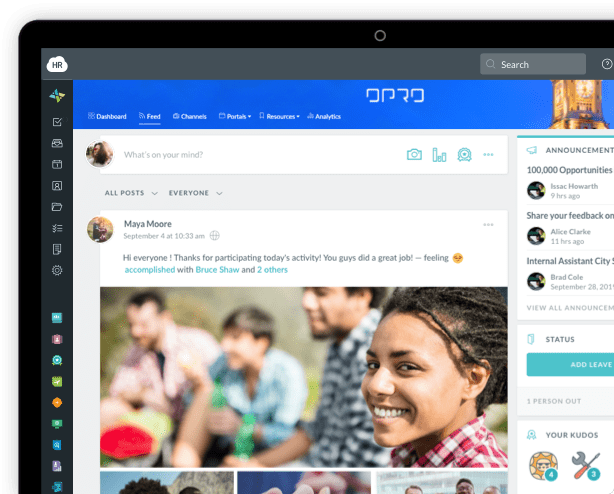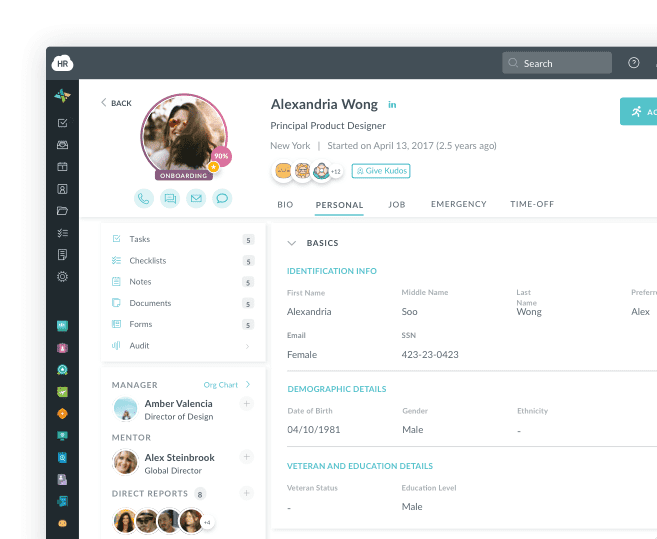Managing Remote Teams in the Tech Industry: Navigating Challenges and Best Practices
-1.png)


 Cut onboarding time
by 60%—here's the
Ultimate Checklist
that helped do it.
Cut onboarding time
by 60%—here's the
Ultimate Checklist
that helped do it.

Since the pandemic, remote work has become widespread across industries, including tech. Reports show a 24% increase in employees opting for remote work in 2022. This shows that work-from-home models are no longer a temporary setting but a corporate norm.
As a staggering number of tech teams went remote, it brought several challenges for the managers, like isolation, reduced morale, and unorganized task delegation.
But to run a successful company, you must regulate your virtual work models. To help you, we have created the perfect playbook to avoid challenges and handle remote tech teams effortlessly.
How To Navigate Remote Tech Teams
Here is how you can effectively navigate your remote tech teams:
-
Address communication gaps
Clear communication is the foundation of any company. While remote work brings several perks, it poses challenges like a lack of trust and synergy in tech teams. This can compromise the information flow, create misunderstandings, and hamper operations.
So, addressing communication gaps in your organization is crucial to run remote tech teams. Use communication tools like Troop Messenger, Slack, Zoom, and Google Meet. Create asynchronous conversations through platforms like Notion and Jira.
Encourage team bonding through regular meetings and interdepartmental brainstorming sessions through video conferences. Identify suitable channels to streamline internal communication so your employees can reach out to peers as required. This way, your remote employees will see themselves as valuable assets and improve their engagement.
-
Promote teamwork and collaboration
A collaborative workspace is critical no matter what work model you opt for. But virtual teams often struggle to collaborate with their onsite colleagues. To avoid this, team leaders need to promote a culture of teamwork and smooth collaboration.
Delegate cross-team projects between your remote tech employees and other departments. Design friendly challenges to encourage healthy competition between the cross-team pairs. Remember to connect employees who usually don’t work together while building a collaborative tech group.
Consider incorporating occasional merchandise for your remote tech teams to enhance team spirit further and boost morale. Providing customized shirts, accessories, and gifts with your company's logo or branding can be a tangible reminder of their connection to the company. Occasional merch not only lifts their mood but also fosters a sense of belonging and appreciation among remote team members, creating a positive work culture even in a virtual environment.
Arrange virtual meet and greets with both onsite and remote tech employees. Create virtual break rooms with good Zoom backgrounds where employees can log in and chat with peers over lunch or tea breaks. Team-building activities like virtual book clubs, yoga sessions, and online games can strengthen the bond between remote tech employees and other departments.

-
Manage productivity and accountability
The lack of face-to-face interaction and limited monitoring makes it challenging to ensure productivity and accountability in remote tech teams. To counter that, you need solid strategies tailored to suit a virtual working model.
Here is what you can do to create a culture of accountability and continuous productivity:
-
Create clear work-from-home policies covering total working hours, required privacy and security measures, deliverables, and expectations.
-
Set realistic targets and define objectives of specific projects.
-
Identify and measure important KPIs and performance metrics.
-
Use performance tracking and project management tools.
-
Practice transparency around the inputs of each remote tech team.
-
Conduct regular follow-ups.
-
Provide reports detailing the remote team’s time expenses.
-
Offer integrations and automation.

-
Navigate time zone differences
Hiring global teams can help you diversify your organization’s culture and bring unique ideas. However, navigating the time difference between remote teams can be tricky.
Here are some measures you can take to navigate time zone differences:
-
Convey your time zone boundaries to the remote tech teams.
-
While setting deadlines, take every team member's location into account.
-
Be very specific about the time zones while discussing dates.
-
Consider split shifts, where one accommodates your time zone and the other caters to the remote team’s time zone.
-
Use scheduled emails so the remote team gets the message when they are active.
-
Embrace modern HR tools
To streamline performance management and ensure employee engagement for remote teams, embrace scalable HR solutions. These tools facilitate smooth onboarding, promote transparency, track performance, and automate repetitive tasks for your employees.
Effective HR platforms also come with chatbots to resolve employee queries quickly. This is especially helpful if you have global teams, as they can get support during working hours.
Modern HR tools come with payroll systems that process timely salary and benefits. These platforms also simplify requesting time offs and managing changes in a remote employee’s schedule.
HR platforms like HR Cloud provide automated onboarding workflows and checklists and manage time offs. The tool also centralizes feedback and handles remote team performance.
Take Advantage of E-Forms, Time-Off Tracking, and Other Powerful Features to Help Drive Your Bussines
Learn More about HRMS
Best Practices for Managing Remote Teams
Follow these best practices to manage remote teams effectively:
-
Establish clear expectations and goals
Remote employees often feel disconnected from the onsite work structure. To mitigate this problem, share expectations and goals from the very start.
While onboarding new employees, define their roles and responsibilities clearly. This will give them an idea of how their contribution fits into the process. Note what you expect from each remote employee and give them an overview of your organization's standard procedures.
Break down responsibilities into small steps for better understanding. You can also use RACI (Responsible, Accountable, Consulted, and Informed) matrix to define each remote worker’s role. This way, your remote team will know exactly what their job entails while working flexible hours.
Clarify deliverables and set relevant performance metrics for each remote team. Track KPIs like devoted work hours, project completion rate, accuracy rate, and individual employee cost. Don’t forget to measure your profit margin regularly after onboarding a remote team. This will give you an idea of how your team contributes towards your business goals.
-
Develop effective communication strategies
Navigating a remote team requires a culture of clear communication. Your remote employees don’t get to interact with their team in person, which can make them feel isolated.
To eliminate this issue, use reliable video conferring platforms so your remote team can stay connected with the rest of your workforce. Incorporate internal chat platforms so that remote teams can reach out to their peers and feel like valuable members of the family.
Schedule regular 1:1 and team meetings with your remote employees. Check-in with them to examine their progress and identify any issues.
Build a culture of open communication. Encourage your virtual assistants and remote employees to state suggestions and opinions in team meetings. Assure they can ask you questions, views, and issues without fear of intimidation. This inclusive approach will enhance collaboration, create a sense of belonging, and reduce employee turnover.
-
Create a virtual team culture
To foster productivity in remote settings, try making your remote team feel at home. Create a culture that fits on-site and virtual teams’ needs and expectations. Encourage them to interact with their peers and build a bond. Virtual events, game nights, and weekend karaoke are fun but beneficial activities to help remote workers gel with their colleagues.
Offer a healthy work-life balance with manageable goals, flexible hours, and paid vacation days. Refrain from contacting them outside their working hours. Also, consider providing gym memberships or yoga classes to help employees regulate work stress and lead a healthy and fulfilling life.
HR Cloud’s time-tracking software will let you keep track of each team’s work hours, manage their time-off requests, and schedule realistic targets for their work days.
-
Provide the right tools and technology
Equip your remote teams with the right tools and technologies so they may deliver quality work. Invest in reliable communication and collaboration platforms, performance analytics, and automation. Ensure the software offers specific features to eliminate different remote team challenges.
For example, besides the necessary HR features, HR Cloud offers a custom form and workflow builder for enhanced efficiency.
-
Empower and support remote team members
To create mutual trust in a remote work model, offer support from day 1 of onboarding. Assist your new hires with all onboarding formalities and provide the necessary resources. Give them time to acclimatize to your procedures. We offer the best-in-class employee onboarding software to get you started on the right foot.
You can assign a mentor for each new hire to provide them with experienced guidance. A workplace buddy also helps remote teams quickly shake off newbie jitters and learn their responsibilities.
Avoid micromanaging your remote team and give them autonomy over their work. This shows your trust in their capabilities and improves engagement.
Identify each team member’s strengths and weaknesses and examine their interests. This way, you can create the perfect training modules for each remote employee to ensure the best possible learning. Your organization should also provide ample upskilling opportunities like online courses, seminars, and certifications. Investing in high-quality resources enables your team to become proficient in Python and other critical skills essential for your tech operations
Conclusion
With an empathetic approach, savvy strategies, and practical HR tools, you can effortlessly navigate the challenges of a remote tech team. However, it’s not something you can perfect overnight. Also, create a timeline to enable you to effect changes and monitor employees' progress properly.
Regularly monitor your work-from-home strategies, identify areas of improvement and make changes accordingly. Collect feedback from employees often and incorporate their suggestions.
Building a mutually respectful, engaged, and productive remote team may seem tricky. But a healthy work-life balance, manageable targets, and the right tools can pave a smooth way to excellence for your virtual team.
Author Bio:
Mehdi Hussen is a SaaS marketing and organic growth consultant. He helps SaaS businesses drive organic growth and customer acquisition through SEO and data-driven content marketing strategies. Mehdi spends his spare time musing about startup growth strategies, personal productivity, and remote work. Connect with him through Twitter or LinkedIn.
Keep Reading
15 Proven Ways to Create a Healthy Work Environment (2026 Guide)
A healthy work environment is a workplace where employees experience psychological
Best Workday Alternatives for Mid-Market Companies in 2026: Complete HRIS Comparison Guide
"We implemented Workday and our HR team still can't figure out half the features six
Company Culture Software: How to Build a Thriving Workplace in 2026
Ask any business leader what drives lasting organizational success, and you'll hear
Like What You Hear?
We'd love to chat with you more about how HR Cloud® can support your business's HR needs. Book Your Free Demo

Build a Culture of Recognition. Boost Engagement. Guaranteed.
Workmates empowers employees to stay informed, connected, and appreciated—whether they’re on the front line, in the office, or remote. Recognition drives 12x higher engagement.Trusted by industry leaders in every sector




Cut Onboarding Costs by 60%.
Take the confusion and follow-ups out of onboarding with automated workflows, digital forms, and structured portals—so new hires ramp faster 3X quicker.Trusted by industry leaders in every sector






